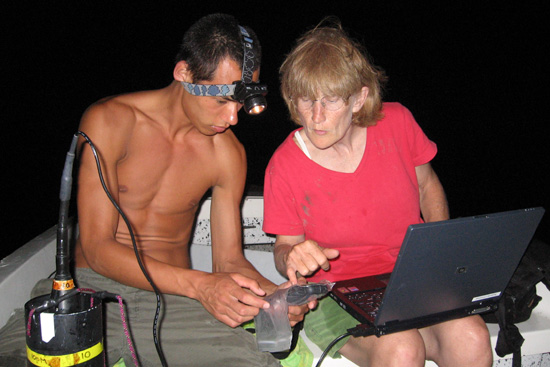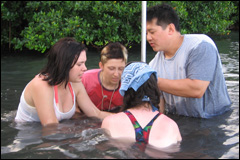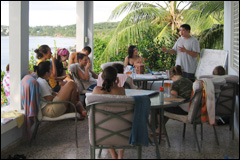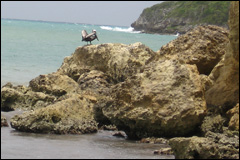Research Team Studies Bioluminescent Bays in Puerto Rico
 |
 At top, Anda Greeney 07 and Suzanne OConnell, associate professor of earth and environmental sciences, prepare to deploy a bathyphotometer, an instrument that measures bioluminescence, into a bay in Vieques, an island off Puerto Rico. At top, Anda Greeney 07 and Suzanne OConnell, associate professor of earth and environmental sciences, prepare to deploy a bathyphotometer, an instrument that measures bioluminescence, into a bay in Vieques, an island off Puerto Rico.
At right, Tim Ku, assistant professor of earth and environmental sciences, shows students how to drill a core sample in a bay they are studying. |
| Posted 07/28/06 |
| Ten miles off the east coast of Puerto Rico, on the island of Vieques, three mangrove-lined bays are illuminated with unicellular marine life known as dinoflagellates. One of the bays has an unusually high abundance of these microscopic creatures that produce their own light through bioluminescence, a chemical reaction similar to the one that makes fireflies glow.
But why do these colorful creatures thrive so well in these bays? That is the question Suzanne OConnell, associate professor of earth and environmental sciences and Tim Ku, assistant professor of earth and environmental sciences, want to answer. As part of a grant-funded research study, OConnell, Ku and Anna Martini of Amherst College took 13 students from eight colleges, including Anda Greeney 07, Andrea Pain 08 and Ulyana Sorokopoud 08, to the Puerto Rican island for a two-week intensive study. The trip was succeeded by two weeks of lab analyses at Wesleyan and Amherst. This ecosystem is so special and were curious to know why so many dinoflagellates live here, Ku says, browsing through digital photos of the turquoise-water bays. Its most likely very fragile. We hope to learn what could destroy them, and also, how to maintain a bay that supports this type of ecosystem. The study, supported by the Keck Geology Consortium (now funded by the National Science Foundation), began June 17. The students and researchers hauled along their necessary research equipment to the Caribbean, including sediment core samplers, water quality monitors and centrifuges.
Every day, the group drove to the south-central side of Vieques, and studied the Puerto Mosquito, Puerto Ferro and Bahia Topin bays, each less than a mile apart from each other. The researchers studied the hydrodynamics of the water, present-day and past sediment sources, nutrient and metal cycles, and satellite imagery to see how the area has changed through anthropogenic development and hurricane activity. Studies were conducted by wading, snorkeling, kayaking or and boating in the bays, and core samples were taken of the layered sediment. These samples will be the basis of the student research throughout the year on campus. Ku says the most bioluminescent bays in Vieques have a narrow opening to the ocean to maintain the necessary balance of temperature and water flow and; the surrounding mangroves may supply other key nutrients to feed the dinoflagellates. In addition, a nearby salt flat may be crucial in providing proper nutrients. On the neighboring island Jamaica, a bioluminescent bay no longer glows at night when developers decided to build a hotel in the salt flats to better see the bay. To conserve these fragile environments we need to understand how they function and how they respond to environmental threats, OConnell says. The bays are a unique find, world-wide. For more than 60 years, theyve have been untouched by developers. The U.S. Navy used sections of the island for military exercises, blocking access to the bays. In 2003, the land was transferred from the Navy to the U.S. Department of Fishing and Wildlife to become a wildlife refuge. Although the lack of development kept the area pristine, pollution from the Navys bombing residues is being studied and activities and plans are underway to clean-up material left by the Navy.
Wesleyan students Greeney, Pain and Sorokopoud, who were funded in-part by the Mellon and Hughes programs, will continue their research during the academic year. Theyve returned home with core samples, which will be examined in depth inside Wesleyan laboratories. OConnell and Ku hope to obtain additional grant funding in the future to continue studying the unique ecosystem. OConnell made her first trip to Vieques seven years ago and returns each year, most recently to teach courses in the Graduate Liberal Studies Program. Once I saw these bays, I fell in love with them, and I want to study them and preserve them, she says. |
| By Olivia Drake, Wesleyan Connection editor. Photos contributed by Tim Ku and Suzanne O’Connell. |


 They rented a house on the ocean, living on the top floor and using the main floor as a laboratory. Ku and OConnell taught classes on the front porch, overlooking the water.
They rented a house on the ocean, living on the top floor and using the main floor as a laboratory. Ku and OConnell taught classes on the front porch, overlooking the water.  But its not only the toxic pollution that concerns the researchers. It’s actually light pollution encroaching on the bays. Light beaming from a full moon alone is enough to hide the brilliant bioluminescence. There are pressures from both individuals and the Puerto Rican government to develop the hills above the bay and in the public beach area to the west.
But its not only the toxic pollution that concerns the researchers. It’s actually light pollution encroaching on the bays. Light beaming from a full moon alone is enough to hide the brilliant bioluminescence. There are pressures from both individuals and the Puerto Rican government to develop the hills above the bay and in the public beach area to the west.